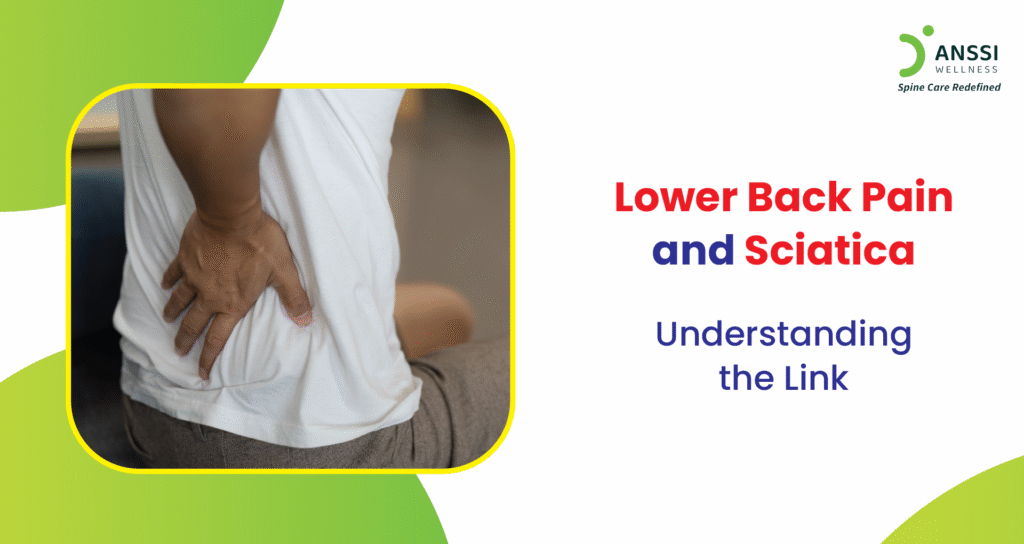Lower back pain is one of the most common health complaints among working adults today. Whether it’s due to long hours at a desk, heavy lifting, or poor posture, almost everyone experiences it at some point.
However, when that pain starts radiating down the leg, it may indicate something more serious. Though often related, lower back pain and sciatica are distinct conditions.
Understanding the connection between the two is crucial for timely treatment and long-term spinal health.
What is Lower Back Pain?
Lower back pain refers to discomfort, stiffness, or aching in the lumbar region, the lower part of the spine that supports most of the body’s weight. This pain can be mild and short-lived or chronic and debilitating.
Common causes include:
- Muscle strain or ligament injury due to overexertion or improper lifting.
- Poor posture while sitting or standing for prolonged periods.
- Degenerative disc issues that occur as the spine ages.
- Herniated or bulging discs that put pressure on spinal nerves.
In many cases, untreated lower back pain is a warning sign of deeper spinal issues. For instance, when a spinal disc slips out of place or loses its cushioning ability, it may compress nearby nerves, including the sciatic nerve.
Understanding Sciatica
Sciatica is not a condition itself but a symptom of an underlying spinal issue. It occurs when the sciatic nerve, the largest nerve in the body, is irritated or compressed. This nerve runs from the lower spine through the hips and down each leg.
When compressed, it causes a distinct pain pattern:
- Sharp or burning pain radiating from the lower back to the buttock and leg.
- Tingling or numbness in the legs or feet.
- Muscle weakness or difficulty standing up after sitting.
While lower back pain may stay localised, sciatica typically follows a nerve path, affecting one side of the body. The root causes are often herniated discs, spinal stenosis, or degenerative disc disease, all of which originate in the lower spine.
The Connection Between Lower Back Pain and Sciatica
Lower back pain and sciatica are closely connected because they often stem from the same spinal problems. When the discs or vertebrae in the lower back become misaligned or damaged, they can compress the sciatic nerve roots.
Here’s how it usually happens:
- A disc bulge or herniation pushes against the nerve root.
- Inflammation develops around the compressed nerve.
- This leads to pain radiating along the sciatic nerve’s path.
Initially, a person might experience mild lower back pain. Over time, if left untreated, this can develop into full-blown sciatica. In this way, chronic lower back pain can be an early indicator of future nerve-related problems.
In other words, not all lower back pain turns into sciatica, but most cases of sciatica start with lower back pain.
Non-Surgical Treatment Options
Thankfully, both lower back pain and sciatica can be effectively managed without surgery. The goal of non-surgical care is to relieve pressure on the spinal nerves, restore spinal alignment, and improve mobility.
1. Non-Surgical Spinal Decompression Treatment
One of the most effective modern treatments is non-surgical spinal decompression treatment, which is a USA protocol-based procedure. This advanced technology gently stretches the spine, creating negative pressure within the discs. This allows bulging or herniated discs to retract naturally, reducing pressure on the sciatic nerve.
The result of spinal decompression – Pain relief without injections, medications, or surgery.
2. Physiotherapy and Targeted Exercises
Physiotherapy helps strengthen the muscles that support the spine while improving posture and flexibility. Specific stretching and strengthening routines relieve pressure from the lower back and prevent recurrence.
Common physiotherapy goals include:
- Improving spinal alignment
- Reducing stiffness in the lumbar area
- Training core muscles for better stability
3. Posture Correction and Ergonomic Changes
Many cases of lower back pain begin with poor posture, especially among desk workers. Ergonomic adjustments like using lumbar support, keeping screens at eye level, and taking regular breaks can reduce spinal stress significantly.
4. Lifestyle Modifications
A sedentary lifestyle, obesity, and smoking can all worsen spinal issues. Regular walking, maintaining a healthy weight, and staying hydrated support spinal health and help prevent disc degeneration.
When to Seek Professional Help
While mild back pain may improve with rest and exercise, persistent or radiating pain should never be ignored. If you experience any of the following symptoms, it’s time to consult a spine specialist:
- Pain that radiates from the back to the leg
- Numbness or tingling in the limbs
- Pain worsening after sitting or standing for long hours
- Loss of strength in the legs
Early intervention can prevent long-term nerve damage and restore full mobility without surgical intervention.
About ANSSI:
ANSSI Wellness focuses on improving the quality of life for patients suffering from spinal issues, aiming to provide relief where other conventional treatments have failed. Through advanced Non-Surgical Spinal Decompression Treatment, ANSSI is committed to helping patients avoid surgery and recover in a safe, effective, and compassionate environment.
Connect with ANSSI Wellness on LinkedIn, Instagram, and Facebook for expert guidance.




